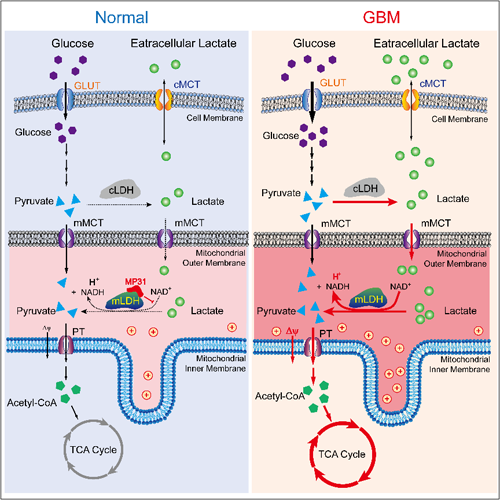Professor Nu Zhang’s team reported that uORF of PTEN could encodes a circuit breaker of lactate metabolism
Source: The First Affiliated Hospital
Edited by: Tan Rongyu, Wang Dongmei
From the perspective of metabolism, tumor cells of GBM could be divided to quiescent cells and rapidly proliferating cells. To date, quiescent GBM cells with stemness property are considered the primary reason for GBM tumorigenesis, therapeutic resistance and recurrence. Although there are no available therapeutic strategies that target these slow-cycling GBM cells, their distinct biological features have drawn attention. Among the prominent differences, proliferative tumor cells prefer aerobic glycolysis (the Warburg effect), whereas slow-cycling cancer cells utilize OXPHOS as the primary energy source. Recent in vivo studies indicated that lactate is preferred to glucose as the primary energy source for the TCA cycle in tumors, suggesting a symbiosis between glycolytic tumor cells and lactate-addicted tumor cells. However, the specific molecular mechanism is still unclear.
Recently, Professor Nu Zhang's team in the department of neurosurgery of the First Affiliated Hospital of Sun Yat-sen University performed ribosome profiling of 10 GBM specimens and paired normal brain tissues (NBs) adjacent to tumors and found a 31aa uORF, located at the 5`UTR of PTEN, with significantly low expression in glioma samples, named MP31. MP31 is a mitochondrial located micropeptide and can act as a ‘circuit breaker’ that limits lactate-pyruvate conversion in mitochondria by competing with mitochondrial lactate dehydrogenase (mLDH) for nicotinamide adenine dinucleotide (NAD+). Knocking out the MP31 homolog in mice enhanced global lactate metabolism, manifesting as accelerated oxidative phosphorylation (OXPHOS) and increased lactate consumption and production. Conditional knockout (cKO) of MP31 homolog in mouse astrocytes initiated gliomagenesis and shortened the overall survival of the animals, establishing a tumor-suppressing role for MP31. Recombinant MP31 administered intraperitoneally penetrated the blood–brain barrier and inhibited mice GBM xenografts without neurological toxicity, suggesting the clinical implication and application of this micropeptide. These findings reveal a novel mode of MP31-orchestrated lactate metabolism reprogramming in glioblastoma.

Figure 1 MP31 regulates lactate metabolism
The research results have been published in
Cell Metabolism (IF=21.567), entitled “An Upstream Open Reading Frame in Phosphatase and Tensin Homolog (PTEN) Encodes A Circuit Breaker of Lactate Metabolism”. The First Affiliated Hospital of Sun Yat-sen University is the unit of the first author and the only corresponding author. The first authors are: Nunu Huang, Fanying Li, Maolei Zhang and Huangkai Zhou. The only corresponding author is Professor Nu Zhang. This paper is finished on the experimental platform of Institute of Precision Medicine the First Affiliated Hospital of Sun Yat-sen University.
This work was supported by the National Natural Science Outstanding Youth Foundation of China, the National Key Research and Development Program of China and the National Natural Science Foundation of China.
Link to the paper:
https://www.cell.com/cell-metabolism/fulltext/S1550-4131(20)30663-X?dgcid=raven_jbs_etoc_email